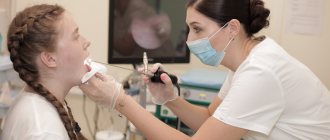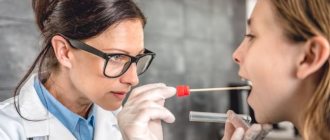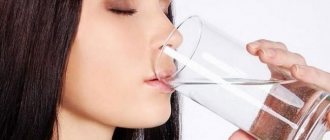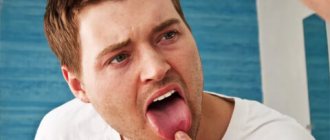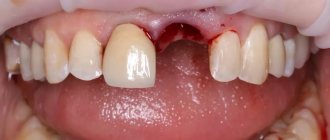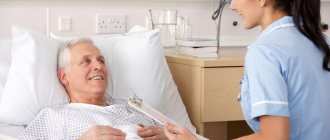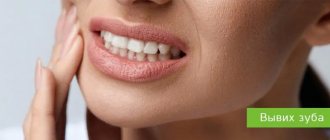general description
Laryngeal spasm (J38.5) is a sudden convulsive spasm of the laryngeal muscles, leading to narrowing and closing of its lumen.
Characteristic for children from 3 months to 2 years. Seasonality: winter, spring. Pathogenesis: increased excitability of the neuromuscular apparatus of the larynx. Predisposing factors:
- artificial feeding,
- hypocalcemia, hypovitaminosis D,
- pneumonia, rickets, spasmophilia, hydrocephalic syndrome, birth trauma.
Provoking factors: air saturated with irritating substances; application of medications to the laryngeal mucosa; diseases leading to irritation of the n.wagus, recurrent laryngeal nerve (goiter, neoplasm); hysteria, crying, coughing, laughing, choking.
3. Symptoms and diagnosis
Against the background of the above conditions, diseases and influences, laryngospasm often develops suddenly. However, in some cases it is preceded by such warning signs as shortness of breath, hoarseness or decreased voice volume (up to complete aphonia), and a “barking” cough with laryngitis. The classic clinical picture of laryngospasm includes changes in complexion, noisy shallow breathing, and panic (which in this condition can rapidly develop not only in a child, but also in an adult). The head is usually thrown back, and with severe hypoxia, cyanosis is observed. Choking, the patient may lose consciousness; in severe cases, cardiac arrest occurs. Sometimes laryngospasm is accompanied by an epileptiform seizure, including involuntary relaxation of the sphincters.
The duration of laryngospasm ranges from a few seconds to several tens of seconds. With hysteria, the attack passes spontaneously and does not require outside help (most often it is enough to eliminate the psychogenic situation or simply deprive the patient of the audience, i.e. leave the room).
If there is a predisposition to laryngospasms, they may occur repeatedly during the day. There is a tendency towards seasonality: laryngeal spasms are more often observed in the cold season.
The diagnosis is established clinically and anamnestiically. During laryngoscopy, a tight closure of the vocal cords and arytenoid cartilages is observed.
About our clinic Chistye Prudy metro station Medintercom page!
Symptoms of laryngeal spasm
Characterized by a sudden acute onset with the appearance of the following signs: noisy difficulty breathing, pale, cyanotic skin of the face, tense neck muscles, thrown back head, open mouth, cold sticky sweat, weak Ps, short-term cessation of breathing. After the attack, breathing becomes normal. With severe spasm, generalized convulsions develop with the appearance of foam at the mouth, loss of consciousness, involuntary urination, defecation, cardiac arrest, and death from suffocation.
4.Treatment
First aid includes providing a supply of fresh, preferably moist, air. It is extremely important to calm the patient and stop panic, but if laryngospasm occurs in a child, this is extremely difficult to do in practice. In some cases, locally distracting pinching, patting, artificially inducing vomiting, or sprinkling the face with drops of water help. It should be remembered that prolonged asphyxia can be fatal; Thus, laryngospasm is an emergency condition and requires an immediate call to the ambulance. In the most severe cases, the patient is intubated or an emergency tracheostomy is performed, but it is obvious that these operations can only be performed by a doctor.
Treatment strategy and tactics are determined by the results of a mandatory diagnostic examination. In particular, the primary measure may be to eliminate hypovitaminosis and micronutrient deficiency. In other cases, neurological or psychotherapeutic treatment is necessary. Physiotherapeutic procedures, restorative measures, and sanatorium-resort treatment play an important role.
It is noted that the tendency to laryngospasm in children usually decreases spontaneously during puberty and adulthood.
Treatment of laryngeal spasm
Treatment is prescribed only after confirmation of the diagnosis by a medical specialist. During an attack, it is necessary to calm the child, provide air access, irritate the nasal mucosa (tickling the nose, ammonia), skin (spray the face with water, prick, pinch), induce a gag reflex, and administer anticonvulsants. In severe cases, tracheal intubation and tracheostomy are required. Hardening, taking calcium, vitamin D, and ultraviolet radiation are indicated.
Essential drugs
There are contraindications. Specialist consultation is required.
- Magnesium sulfate (sedative, anticonvulsant). Dosage regimen: IM, 0.2 ml 25% solution per 1 kg of child’s weight.
- Diazepam (tranquilizing, muscle relaxant). Dosage regimen: IM, IV 10–20 mg.
- Calcium chloride (stimulant of the sympathetic nervous system). Dosage regimen: intravenous jet, slowly, 5 ml of 10% solution.
- Succinylcholine (ultra-short muscle relaxant). Dosage regimen: IV, at a dose of 0.1–0.3 mg/kg; or IM at a dose of 0.2–0.6 mg/kg.
| • | Leading specialists and institutions for the treatment of this disease in Russia: |
| Bogomilsky M.N., Russian National Research Medical University named after. N.I. Pirogov, Moscow; z.o. Doctor of Medical Sciences Artyushkin S.A., Pokrovskaya Hospital, St. Petersburg; z.o. Astaschenko S.V., St. Petersburg Research Institute of Ear, Throat, Nose and Speech. | |
| • | Leading specialists and institutions for the treatment of this disease in the world: |
| ICHILOV MEDICAL CENTER, Tel Aviv. |
2. Reasons
Laryngospasm is a neuromuscular reflex that can be caused by many factors.
The main groups of such reasons include:
- inflammation in the respiratory system (pneumonia, bronchitis, tracheitis, laryngitis, etc.);
- neurodegenerative diseases (especially those affecting the spinal cord);
- infections and tumors of the central nervous system;
- severe generalized infections (eg, tetanus);
- irritation of the larynx with chemicals, allergens, medications, very cold or hot air;
- deficiency of vitamins and/or microelements;
- vascular pathology (severe hypertension, aortic aneurysm, etc.);
- neuropsychic factors (psychotrauma, hysterical attack, nervous overstrain, severe crying in children, fear or laughter);
- foreign bodies or tumors in the upper respiratory tract.
Visit our Otolaryngology (ENT) page
Incidence (per 100,000 people)
| Men | Women | |||||||||||||
| Age, years | 0-1 | 1-3 | 3-14 | 14-25 | 25-40 | 40-60 | 60 + | 0-1 | 1-3 | 3-14 | 14-25 | 25-40 | 40-60 | 60 + |
| Number of sick people | 0 | 0 | 0.1 | 1 | 1 | 1 | 1 | 0 | 0 | 0.1 | 1 | 1 | 1 | 1 |
How to get rid of a sore throat
Considering that a sore throat is most often caused by viruses, antibiotics will not help, but, on the contrary, can aggravate the problem by disrupting the balance of microflora and promoting the development of fungus.
The only exception is the appearance of severe pain and sore throat due to a sore throat. The most dangerous sore throat is caused by infection with group A beta hemolytic streptococcus (GABHS). GABHS can be detected in 5 minutes both at a doctor’s appointment and at home using a test. The infection affects the tonsils, causing high fever (up to 40 degrees), severe sore throat, which makes it difficult to swallow. During a sore throat, the tonsils are enlarged, red, covered with plaque or pus.
Such a sore throat caused by GABHS must be treated with antibiotics so that serious complications from the heart, kidneys and joints do not occur. But a doctor must prescribe antibiotics.
In all other cases, it is better to limit yourself to local remedies. Rinsing with herbs or a simple salt solution is a good way to relieve the condition - just not a strong one, as is often recommended, but isotonic: one teaspoon of salt per liter of water. For children who are too young to gargle, you can irrigate the back of the throat with it or inhalate it using a nebulizer. This way you can reduce not only a sore throat, but also relieve pain and cough. Such methods eliminate the manifestations of the disease, but not its cause, so you should not limit yourself to rinsing and inhalation.
Remedies for a sore throat should moisturize the mucous membrane, stimulate its protective properties and fight infection. That is why health experts are increasingly saying that topical (local) therapy should be the main treatment for sore throat and sore throat.
Treatment of the disease
The laryngeal spasm may last 1-3 seconds and go away on its own. A longer spasm of the throat is life-threatening, so you need to know what kind of help is required in this situation.
Measures to get rid of throat spasms:
- Ensure complete rest for the patient, open the window to ventilate the room.
- Give me some water to drink.
- If you lose consciousness, use ammonia.
If these methods do not help, you should hold your breath for a while, slap your back, and artificially induce vomiting. When the attack lasts a long time, you need to take a bath with warm water. It relieves tension, relaxes and helps calm the throat.
Basic therapy for the pathology depends on the cause that caused the throat spasm. Therefore, there are a sufficient number of methods to combat symptoms.
To stop an allergic attack, antihistamines are prescribed:
| Drugs | Photo | Price |
| Suprastin | From 125 rub. | |
| Diphenhydramine | From 26 rub. | |
| Tavegil | From 175 rub. |
When asthma is the cause of throat suffocation, bronchodilators will help:
| Drugs | Photo | Price |
| Ephedrine | Check | |
| Teofedrine | Check | |
| Anasman | Check |
A quick effect for throat spasms can be achieved by using Berodual as an inhalation.
Surgical treatment of the throat is carried out if the resulting tumor compresses the organs of the neck. Malignant tumors are treated with radiation and chemotherapy.
Treatment with folk remedies
Some folk remedies can be used as preventive methods for children and adults.
- Milk with honey. Every evening you need to drink a glass of warm milk with 1 tsp. honey You should also add cinnamon, cloves, and a little propolis to the milk. This drink softens the respiratory tract.
- Inhalations. If you don’t have a nebulizer, you can breathe over a pan of hot water by adding 2 tbsp soda to it. l. for 500 ml of water. You need to inhale the steam for 15 minutes. Such procedures are carried out every day for a month.
- Steam baths. A small child can be kept in the bathroom by first drawing a bath of hot water and adding a decoction of herbs - sage, mint, thyme. You need to sit with your child in the bathroom for 10-15 minutes so that he can breathe in the healing steam.
- Pine resin. In the morning and evening, it is necessary to slowly dissolve fresh pine resin. Adults should dissolve 1 tsp. oleoresin, children under 12 years old - half a teaspoon. You can dissolve resin in milk.
- Chamomile tea. It is useful for adults; chamomile tea can also be drunk by children from 9 months. Chamomile can be brewed not in water, but in milk.
- Chokeberry. Fresh fruits need to be ground, added sugar and kept in the refrigerator. In the morning on an empty stomach, eat 1 tsp. take this remedy with water.
- Wine tincture. Mix 1 tbsp. l. thyme, rosemary, meadow geranium, mint, marianberry, ginger root, half a teaspoon of red pepper. Pour all the mixed herbs into 1 liter of Cahors wine, heated to 75 degrees. Leave for two days, then strain and drink 50 ml in the evening. The course lasts until the tincture runs out. This method can only be practiced by adults.
Prevention
It is completely impossible to insure yourself against the manifestation of throat spasms, however, by following some rules, you can reduce possible risks to a minimum.
Recommendations to help avoid throat spasms, pain, and choking:
- Observe the work and rest schedule. Eat properly.
- Avoid stress.
- Treat associated ailments in a timely manner.
Throat spasms are an unpleasant and dangerous painful condition that can lead to the death of the patient. Therefore, when you notice the first signs of throat spasms, you should seek help from a doctor, which will make it possible to prevent the occurrence of serious complications.
Imudon® for sore throat
The drug has a wide spectrum of action and is used for diseases caused by viruses, bacteria and fungi. Imudon® contains lysates of bacteria and fungi of the genus candida4 - that is, the most common infectious agents, which helps activate the body's protective immune reactions against them. Viruses are affected by interferons and lysozyme, which the body produces itself during the use of the drug. Therefore, Imudon® is effective for both acute and chronic diseases that cause a sore throat in children and adults5,6,7.
Diagnostic measures
If there are frequent manifestations of spasms that are not related to the effects of chemical and mechanical irritants, or the emotional background of the patient, then a specialist will prescribe a comprehensive examination. Thanks to diagnostics, it will be possible to identify the causes of the patient’s pathological condition and prescribe appropriate treatment.
The main methods for diagnosing diseases that are accompanied by the formation of a spasm in the throat include several studies.
Pharyngoscopy - the study involves a visual examination of the throat using a spatula. The doctor takes a swab from the throat and prescribes biochemical and general blood tests, which will show possible inflammatory processes affecting the pharynx. If a tumor formation is suspected, a tumor marker test is prescribed.
Laryngoscopy is a diagnostic method that makes it possible to assess the condition of the pharyngeal mucosa and vocal passage.
Fibroesophagogastroduodenoscopy - with this method you can find the cause of the disease along the digestive tube.
The doctor may also prescribe an ultrasound examination for spasms, which is used to rule out thyroid disease.
The choice of one or another diagnostic method for spasms depends on the pathology progressing in the body, which led to the occurrence of a spasmodic condition in the throat.
